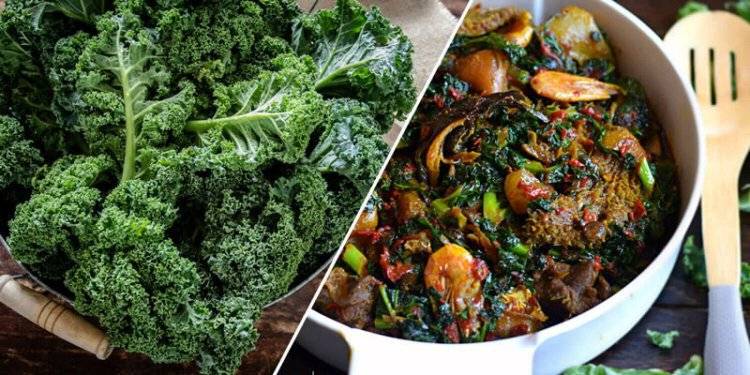Kale vegetable
Kale is not a new vegetable, although many may have just started hearing more about it. Kale is much more than the normal vegetable due to its rich nutrient; it is a superfood! As a powerhouse of nutrition, kale has come to be popularly known as the “queen of greens”.
This popular vegetable belongs to the cabbage family. Kale is categorised as a cruciferous vegetable like cabbage, broccoli, cauliflower, and Brussels sprouts. Kale comes in different colours (white, red, yellow-green, and purple)
Potassium is found in kale which maintains the electrical gradient cells in the body and is connected to reduced blood pressure and lowers the risk of heart disease. Over other greens, kale is low in oxalate, a substance that prevents minerals from being absorbed.
As a super rich vegetable, Kale contains powerful antioxidants like flavonoids, quercetin and kaempferol. These substances have powerful anti-inflammatory, anti-viral, anti-depressant, and anti-cancer effects. Kale contains roughly 4.5 times more vitamin C than spinach. Again, it is also one of the best sources of vitamin K that will help sort out clotting issues, support bone development, and support the cardiovascular system.
Health benefits of kale:
Low in calories.
Kale is a nutrient-dense, low-calorie food, implying that kale is a great addition to your diet if you are trying to lose weight. One cup of raw kale has just 33 calories and only 7 grams of carbohydrate. As a low calorie food, it is very healthy for the body digestive organs especially the Liver and pancreas. The high water content of kale and the low-calorie content in it helps to keep one feeling full for a long period. This reduces hunger pangs, help maintain body fat , which invariably helps to lose body weight and not gain much. So, it’s a very diabetes-friendly/weight-friendly vegetable.
Lowers Cholesterol
Kale’s function in the body is multiple. When eaten, kale produces bile acid sequestrants that help the body to successfully digest fat. So as the body uses the bile acid to clear off cholesterol, the bile acid is reabsorbed into the bloodstream and comes out again when needed to perform the same function. So over time, this reduces the risk of heart disease. A study reveals that increased drinking of kale juice every day for 12 weeks, increased the good cholesterol (HDL) by a 27% chance thus lowering the bad cholesterol (LDL) by 10%, and just as steaming kale give a higher dose of iron, steamed kale increases the bile acid-binding effect. The same study still showed that steamed Kale is 43% potent as cholestyramine, a drug used to lower cholesterol.
Kale promotes liver health.
Kale is filled with fiber and sulfur, both great for supporting your body’s natural detoxification process and keeping your liver healthy. Kale is part of the cruciferous vegetable family, which may promote healthy digestion and can remove pollutants from the bloodstream.
Easily aids digestion.
As a fibrous leafy green, kale is great for aiding in digestion and elimination. Don’t discard the stems, which are a rich source of prebiotics, which are food for your microbiome. While they’re tough raw, sautéed in a bit of avocado or olive oil with some sea salt, they become a delicious, breadstick-like treat.
Baked Mackerel fish with kale
It is loaded with antioxidants
Kale is a rich source of antioxidants that stops up to 99% of free radicals. As a fighter for good health, kale has carotenoids, flavonoids, and more that help protect against various cancer cell growth. One of such fighting properties is sulforaphane which fights cancer at the molecular level. Indole-3-carbinol is believed to prevent cancer. Studies have shown that cruciferous vegetables like kale may significantly lower the risk of several cancers, though this evidence in humans is not sure. These antioxidants are heat sensitive. To better preserve their functions, they can be incorporated in smoothies and salads.
Helps Prevent Cancer
Kale contains cancer-fighting carotenoids, which are antioxidants that protect cell DNA from damage caused by free radicals – these damages are associated with causing cancer. Kale is one of the richest food with Vitamin C. This Vitamin C helps to reduce inflammation, strengthen the immune system, and fight oxidative stress, which can help prevent cancer and other illnesses like the common cold and the flu. The recommended daily intake of vitamin C is 90 mg for adults, which is about 4.25 cups of cooked kale.
Enhances Bone Health.
This leafy dense vegetable is filled with vitamin K1 and K2 as they activate certain proteins with the ability used to bind calcium. Vitamin K2 supports bone development ensuring that the bone is built to replace the bone that is broken down. It can achieve this because vitamin K2 activates a protein known as osteocalcin that ensures sufficient build-up of bone to replace that which is broken down. It also helps another protein “matrix gla” to encourage artery health. It discourages calcium from holding on to the wall. Do you know that this leafy green has more calcium than milk? Again for support, it builds strong bones, and blood vessels transport blood through the body.
Aids in Healthy Eyesight
Kale also contains the vitamins lutein and zeaxanthin, which contribute to healthy eye cells and help lower the risk of age-related macular degeneration. It is ruch in beta carotene which then turns into vitamin A which is great to enhance support of the normal vision
Good for the Heart and Helps Stop Bleeding
Kale assists in building up the haemoglobin and enzymes that send oxygen to various parts of the body. Cooking your kale will increase the iron quantity of this green and added with a rich dose of vitamin C, this will help the body absorb the iron in kale.
Like other vegetables that are rich in beta-carotene, kale is too. This helps to keep certain blood organs healthy. It also aids the proper functioning of the heart, lungs, kidney, and other organs. Kale is rich in Vitamin K2, a coagulation vitamin that helps the blood clot with ease and in a healthy manner to stop excess bleeding. For women who go through the bleeding process every month, kale should be your best friend because of the iron it willingly offers and blood clotting abilities.
Improves Skin Health and Appearance
You don;t have to pay heavily for a good skincare product, when you have this super vegetable. This vegetable doesn’t only improve your waistline and help reduce the risk of certain illnesses, it can also improve your skin.
Vitamin A (retinol) is essential for healthy cell growth, and a vitamin A deficiency often leads to dry skin and acne.
How to Eat Kale
Kale can be prepared and eaten in many forms; Kale has hearty leaves that withstand all types of cooking:. It van be eaten raw, as it has a cruncy feel, although it can be hard. It can be steamed, sauted or stir fried. Kale can be cooked with spices to make vegetable soups like “efo-riro” or “efo-elegusi”. It can also be used in maing salads.
Caveat:
In as much as Kale is a super food, one has to be careful while consuming. People who may need to avoid or limit kale intake are those that have suffered or suffer from kidney stones. More so, because kale is a source of vitamin K, which promotes healthy blood clotting, people who take blood thinners should speak with their doctor to see how much they can safely eat. Kale also contains thiocyanate, and in large doses, this substance can trigger an iodine deficiency. Be sure to check with your doctor or dietitian if you have questions.


